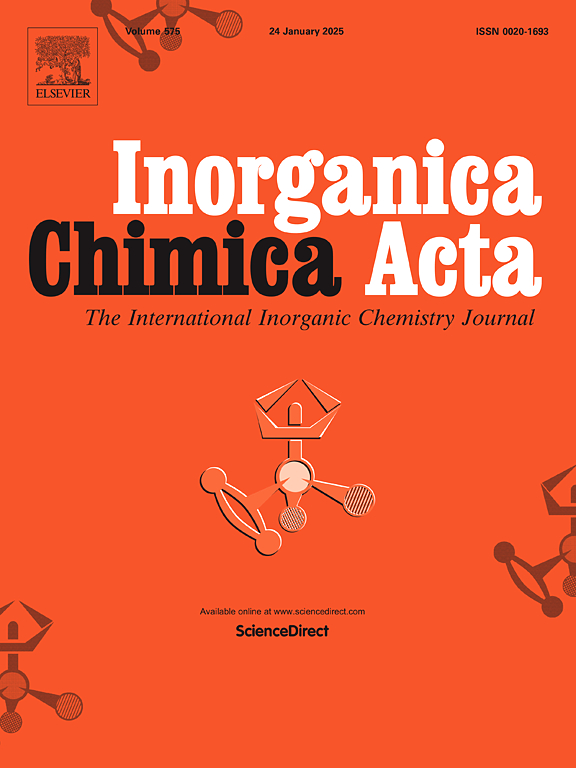一种具有三亚二胺希夫碱配体的新型CuI配位聚合物:结构、光谱、理论和分子对接研究
IF 3.2
3区 化学
Q2 CHEMISTRY, INORGANIC & NUCLEAR
引用次数: 0
摘要
在这项工作中,我们合成了一个新的聚合物Cu(I)配合物,[Cu(L4Br)I]n,由salpn型席夫碱配体(L4Br = n, n ' -双(4-溴苄基)丙烷-1,3-二胺)衍生而来。除了核磁共振研究外,利用单晶x射线衍射(SC-XRD)确定了晶体结构,揭示了希夫碱铜配合物形成了双核一维(1D)聚合物。在这种结构中,铜原子和碘原子形成聚合键,而希夫碱的亚胺氮原子都与铜中心配位。席夫碱和碘化物配体与铜中心配合,导致每个铜原子周围的三角形平面几何形状略有扭曲。Hirshfeld表面分析表明,H、I相互作用是形成超分子结构的主要因素,而CuI对表现出最高的相互作用趋势,与聚合物键的形成相对应。单晶胞含有11.1%的空隙空间,这表明最小的体积表明有利的机械性能。利用Def2-TZVP基集的B3LYP函数对分子结构进行了优化,结果表明,计算得到的ICu和CuN键长与实验结果吻合较好。分子静电势(MEP)分析揭示了电负性原子周围的富电子区域,特别是碘和氮,是与亲电物质相互作用的潜在位点。NBO分析表明,卤化物向相邻铜中心的电子捐赠显著,表明它们在配位范围内具有很强的给电子能力。铜原子表现出正的NPA电荷(~ 0.35),证实了它们作为金属中心的电子接受作用。配合物[Cu(L4Br)I]n的优化几何形状被用作AutoDock Vina进行分子对接研究的输入。DNA和BSA的结合常数(Kb)使用公式ΔG°b = - RTlnKb计算,其中计算的负ΔG°b值证实了结合过程的自发性。本文章由计算机程序翻译,如有差异,请以英文原文为准。

A novel CuI coordination polymer featuring a trimethylenediamine Schiff base ligand: Structural, spectroscopic, theoretical, and molecular docking studies
In this work, we synthesized a new polymeric Cu(I) complex, [Cu(L4Br)I]n, derived from a Salpn-type Schiff base ligand (L4Br = N,N′-bis(4-bromobenzylidene)propane-1,3-diamine). In addition to NMR studies, the crystal structure was determined using single-crystal X-ray diffraction (SC-XRD), revealing that the Schiff base copper complex forms a binuclear one-dimensional (1D) polymer. In this structure, copper and iodide atoms form polymeric linkages, while both imine nitrogen atoms of the Schiff base coordinate with the copper centers. The Schiff base and iodide ligands coordinate to the copper centers, resulting in a slightly distorted trigonal planar geometry around each Cu atom. Hirshfeld surface analysis revealed that H┄I interactions are the dominant contributors to the supramolecular architecture, while the Cu![]() I pairs exhibit the highest interaction tendency, corresponding to the formation of polymeric bonds. The unit cell contains 11.1 % void space, indicating a minimal volume that suggests favorable mechanical properties. The molecular structure was optimized using the B3LYP functional with the Def2-TZVP basis set, showing good agreement between the calculated and experimental I
I pairs exhibit the highest interaction tendency, corresponding to the formation of polymeric bonds. The unit cell contains 11.1 % void space, indicating a minimal volume that suggests favorable mechanical properties. The molecular structure was optimized using the B3LYP functional with the Def2-TZVP basis set, showing good agreement between the calculated and experimental I![]() Cu and Cu
Cu and Cu![]() N bond lengths. Molecular electrostatic potential (MEP) analysis revealed electron-rich regions around electronegative atoms, particularly iodine and nitrogen, as potential sites for interactions with electrophilic species. NBO analysis indicated significant electron donation from halides to adjacent copper centers, highlighting their strong donor capability within the coordination sphere. The copper atoms exhibit positive NPA charges (∼0.35), confirming their electron-accepting role as metal centers. The optimized geometry of the complex [Cu(L4Br)I]n was used as input for molecular docking studies performed with AutoDock Vina. Binding constants (Kb) for DNA and BSA were calculated using the equation ΔG°b = −RTlnKb, where the calculated negative ΔG°b values confirm the spontaneity of the binding processes.
N bond lengths. Molecular electrostatic potential (MEP) analysis revealed electron-rich regions around electronegative atoms, particularly iodine and nitrogen, as potential sites for interactions with electrophilic species. NBO analysis indicated significant electron donation from halides to adjacent copper centers, highlighting their strong donor capability within the coordination sphere. The copper atoms exhibit positive NPA charges (∼0.35), confirming their electron-accepting role as metal centers. The optimized geometry of the complex [Cu(L4Br)I]n was used as input for molecular docking studies performed with AutoDock Vina. Binding constants (Kb) for DNA and BSA were calculated using the equation ΔG°b = −RTlnKb, where the calculated negative ΔG°b values confirm the spontaneity of the binding processes.
求助全文
通过发布文献求助,成功后即可免费获取论文全文。
去求助
来源期刊

Inorganica Chimica Acta
化学-无机化学与核化学
CiteScore
6.00
自引率
3.60%
发文量
440
审稿时长
35 days
期刊介绍:
Inorganica Chimica Acta is an established international forum for all aspects of advanced Inorganic Chemistry. Original papers of high scientific level and interest are published in the form of Articles and Reviews.
Topics covered include:
• chemistry of the main group elements and the d- and f-block metals, including the synthesis, characterization and reactivity of coordination, organometallic, biomimetic, supramolecular coordination compounds, including associated computational studies;
• synthesis, physico-chemical properties, applications of molecule-based nano-scaled clusters and nanomaterials designed using the principles of coordination chemistry, as well as coordination polymers (CPs), metal-organic frameworks (MOFs), metal-organic polyhedra (MPOs);
• reaction mechanisms and physico-chemical investigations computational studies of metalloenzymes and their models;
• applications of inorganic compounds, metallodrugs and molecule-based materials.
Papers composed primarily of structural reports will typically not be considered for publication.
 求助内容:
求助内容: 应助结果提醒方式:
应助结果提醒方式:


